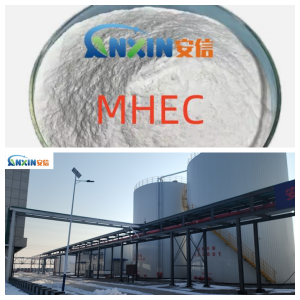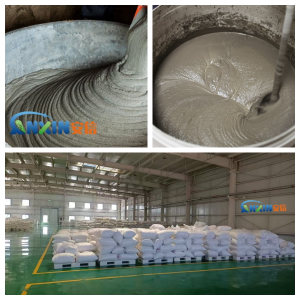In modern construction, the workability of mortars directly impacts project quality and efficiency. Rheological properties, a key indicator of mortar workability and stability, are influenced by the mortar’s raw materials and mix ratio. In recent years, methyl hydroxyethyl cellulose (MHEC) has become a key additive for optimizing the rheological properties of construction mortars due to its excellent thickening and water-retention properties.
1. Basic Properties of MHEC
MHEC is a water-soluble cellulose ether formed by replacing the hydroxyl groups in the cellulose molecule with methyl and hydroxyethyl groups. Its key properties include:
Good thickening properties: MHEC forms a high molecular weight network in water, imparting high viscosity to the mortar system, improving fluidity and suspension capabilities.
Excellent water retention: MHEC significantly reduces water loss during mortar construction, ensuring workability and strength development in dry conditions.
Dispersibility and stability: MHEC disperses evenly in cement mortar, avoiding localized aggregation and ensuring uniform mortar mixing.
Heat and chemical resistance: MHEC remains stable at room temperature and is resistant to attack by common chemicals in the construction environment.
2. Mechanism of MHEC Optimizing Mortar Rheological Properties
2.1. Network Structure Formation
When dissolved in water, MHEC forms a molecular chain network that interacts with the cement particles and mineral powders in the mortar. This network structure creates a lubricating layer between the particles, allowing the mortar to flow smoothly under shear and exhibit good resistance to settling when left to stand.
2.2. Water Absorption and Moisturizing Effect
During mortar construction, rapid evaporation of water can lead to decreased slump and poor adhesion. MHEC’s high water retention locks in moisture, extending the open time of the mortar and enabling more flexible construction. It also provides a continuous water source for cement hydration, promoting early strength development.
2.3. Shear Thinning Effect
MHEC mortar exhibits high viscosity under low shear, preventing mortar settling and delamination. Under high shear (such as during pumping or plastering), the viscosity decreases, exhibiting excellent flow. This non-Newtonian fluid behavior ensures optimal mortar performance during both the construction and curing stages.
2.3. Particle Dispersion and Agglomeration Prevention
MHEC evenly distributes itself throughout the mortar, ensuring uniform suspension of cement particles and fillers, thereby preventing localized strength variations and construction inconvenience caused by particle agglomeration.
3. Applications of MHEC in Different Mortar Types
3.1. Plastering Mortar
Adding MHEC to plastering mortar improves its adhesion and ease of application, ensuring even spreading on the wall surface and preventing slumping or sanding.
3.2. Dry-Mixed Mortar
Dry-mixed mortar requires immediate application by adding water to the construction site. MHEC improves the mortar’s consistency and water retention, ensuring a uniform and easy-to-apply mortar after mixing, while also extending the construction window.
3.3. Self-Leveling Mortar
For self-leveling mortar, controlling fluidity and viscosity is crucial. An appropriate amount of MHEC can adjust the mortar’s viscosity, ensuring the mortar levels itself after pouring, while also maintaining its anti-settling properties and preventing stratification and air bubble formation.
4. Practical Results of MHEC in Optimizing Mortar Workability
Extensive project experience demonstrates that the proper use of MHEC can significantly improve mortar workability:
Improved fluidity: Mortar slump remains within the ideal range, enabling smoother pumping and plastering.
Enhanced anti-settling properties: Mortar is less likely to separate during standing, and powder particles are evenly distributed.
Improved adhesion: Mortar adheres more tightly to the substrate, reducing the risk of detachment.
Extended working window: High water retention allows construction workers more time to work in dry or hot environments.
5. MHEC Dosage and Usage Recommendations in Mortar
Depending on the mortar type, environmental conditions, and construction requirements, the MHEC dosage is typically between 0.1% and 0.5% (based on the weight of dry mortar powder). During application, the following precautions should be taken:
Uniform dispersion: Ensure MHEC is fully dissolved in water before adding to the mortar to avoid clumping.
Coordination with other admixtures: The dosage should be adjusted based on the overall mortar properties, such as retarders, water-retaining agents, or pumping agents, to avoid performance conflicts. Environmental Adaptability: The dosage can be increased appropriately in hot and dry environments to enhance water retention.
MHEC, thanks to its excellent thickening, water retention, and rheology-modifying properties, is increasingly being used in building mortars. By adjusting mortar viscosity, improving workability, and extending the working window, MHEC effectively enhances the overall workability of the mortar, providing a solid foundation for high-quality construction projects. In the future, with the continuous advancement of building materials technology, the optimization of MHEC’s formulation and expansion of its functionality will provide even greater possibilities for mortar workability, achieving both improved construction efficiency and project quality.
Post time: Oct-24-2025








